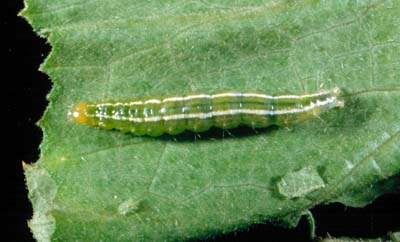
Melonworm, Diaphania hyalinata, mature larva.
(Photographer: J. Capinera, University of Florida)
The melonworm is restricted to feeding on cucurbits. Hosts include pumpkin, cucumber, squash, gherkin, and cantaloupe, with summer and winter squash its main host. The melonworm feeds primarily on foliage and may also feed on the rinds of fruit. In some circumstances, the melonworm may burrow in fruit. Melonworm is sometimes referred to as a rindworm. Young plants should be sampled for melonworm by checking plants for early stages of leaf damage and the presence of larvae. A variety of insecticides are available to control melonworm but should be used selectively because of pollinators that are required for the crop. Row covers may also be used in small plots to exclude melonworm adults. Trap crops (early plantings) may also be used and destruction of plant residues is recommended.
Images
To save the Web-optimized images shown below to your hard drive:
|
Click to access Display and Print quality images. |
|
Click to access Display and Print quality images. |
|
Click to access Display and Print quality images. |
|
Click to access Display and Print quality images. |
|
Click to access Display and Print quality images. |